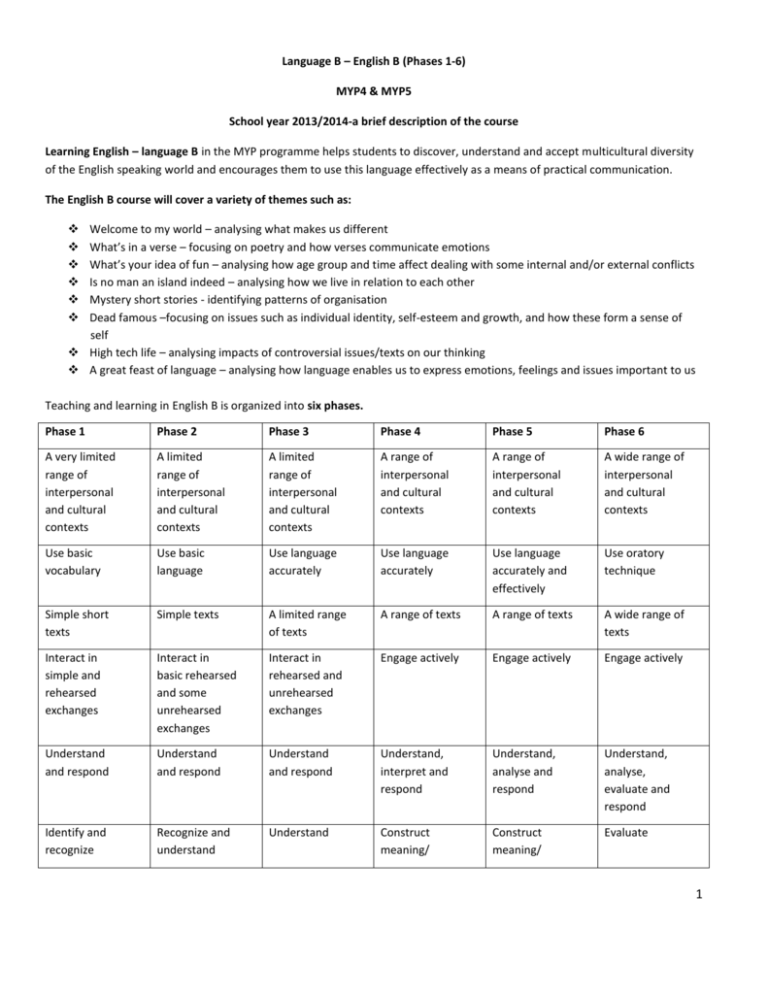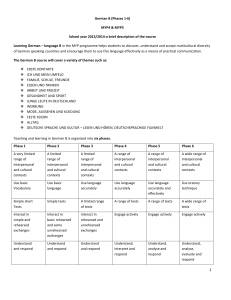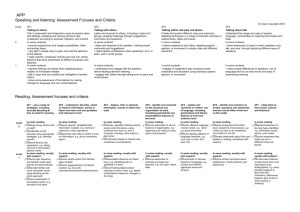Language B – English B (Phases 1
advertisement

Language B – English B (Phases 1-6) MYP4 & MYP5 School year 2013/2014-a brief description of the course Learning English – language B in the MYP programme helps students to discover, understand and accept multicultural diversity of the English speaking world and encourages them to use this language effectively as a means of practical communication. The English B course will cover a variety of themes such as: Welcome to my world – analysing what makes us different What’s in a verse – focusing on poetry and how verses communicate emotions What’s your idea of fun – analysing how age group and time affect dealing with some internal and/or external conflicts Is no man an island indeed – analysing how we live in relation to each other Mystery short stories - identifying patterns of organisation Dead famous –focusing on issues such as individual identity, self-esteem and growth, and how these form a sense of self High tech life – analysing impacts of controversial issues/texts on our thinking A great feast of language – analysing how language enables us to express emotions, feelings and issues important to us Teaching and learning in English B is organized into six phases. Phase 1 Phase 2 Phase 3 Phase 4 Phase 5 Phase 6 A very limited range of interpersonal and cultural contexts A limited range of interpersonal and cultural contexts A limited range of interpersonal and cultural contexts A range of interpersonal and cultural contexts A range of interpersonal and cultural contexts A wide range of interpersonal and cultural contexts Use basic vocabulary Use basic language Use language accurately Use language accurately Use language accurately and effectively Use oratory technique Simple short texts Simple texts A limited range of texts A range of texts A range of texts A wide range of texts Interact in simple and rehearsed exchanges Interact in basic rehearsed and some unrehearsed exchanges Interact in rehearsed and unrehearsed exchanges Engage actively Engage actively Engage actively Understand and respond Understand and respond Understand and respond Understand, interpret and respond Understand, analyse and respond Understand, analyse, evaluate and respond Identify and recognize Recognize and understand Understand Construct meaning/ Construct meaning/ Evaluate 1 interpret analyse In MYP English B, the purposes and targets for learning language are divided into three areas of communication: • Oral communication • Visual communication • Written communication The areas of communication are organized into four communicative processes. The four communicative processes become four objectives with four corresponding sets of criteria. Objective A—oral communication - Oral communication encompasses all aspects of listening and speaking. Objective B—visual interpretation - Visual communication encompasses all aspects of viewing and presenting Objective C—reading comprehension Objective D—writing - Written communication encompasses all aspects of reading and writing. ASSESSMENT STRATEGIES: Students will be assessed continually – in formative and summative way - through oral and written activities: written production, reading comprehension, linguistic tests (grammar, vocabulary), quizzes, oral presentations, teamwork, homework exercises, dictations, projects, class cooperation, behaviour and personal participation. In order to measure a student’s progress and achievement in each phase of the course, four criteria have been established by the IB. These criteria correspond directly to the four objectives. A: Oral communication—to measure the student’s development as a speaker of the language B: Visual interpretation—to measure the student’s ability to interpret visual text presented with spoken and written text C: Reading comprehension—to measure the student’s ability to comprehend written text D: Writing—to measure the student’s development as a writer of the target language For each objective for each of the six phases, criteria have been devised. Criterion A Oral communication Maximum 8 Criterion B Visual interpretation Maximum 8 Criterion C Reading comprehension Maximum 8 Criterion D Writing Maximum 8 The assessment criteria and assessment tasks are presented to students at the beginning of a task/project. Materials are chosen from appropriate text–books (A. Hancock, A. McDonald, English Result Intermediate, Oxford University Press) and from a number of authentic sources such as reference materials from the school library, songs, shorts stories, magazines and cartoons, audio-visual materials designed for native speakers of English, classic literature, radio, television, films and the Internet. At the end of the each Unit the students will have to fill in the self-reflection and self-evaluation sheet and sometimes the Language Portfolio-self assessment sheet. 2 ASSESSMENT: At the end of the school year points are given in each criteria taking into account achievements in all individual tasks (formative and summative assessment). Final grades are derived according to the grade boundaries provided by the IB: Language B all phases Grade Boundaries 1 0-3 2 4-7 3 8-12 4 13-17 5 18-22 6 23-27 7 28-32 3








